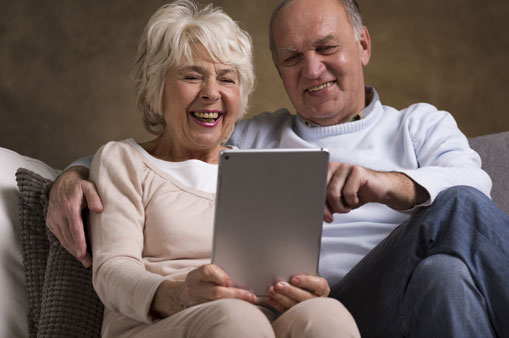Technology for Seniors

TECHNOLOGY
Innovative software relieves the burden of looking
after elderly parents.
Many owner-managers in their thirties and forties or
even older not only have to run their businesses but
also have to look after growing children as well as
aging parents. These owner-managers are part of the
so-called “sandwich generation,” trying to be successful
business people but also caught between two levels of
family responsibility. First, they have to cope with the
physical and mental exhaustion of the job, then take
on the responsibilities of caring for parents who might
have reached the “critical-needs” point in their lives.
Add to that the potential high costs associated especially
with seniors’ residences and the time-consuming
responsibilities of being power of attorney and it is little
wonder the sandwich generation is looking for help.
There are, of course, marginally beneficial tax breaks
and social programs that assist, but these cannot meet
the 24/7 on-call requirements needed by a concerned
child of elderly parents.
New Software Available
Innovative software is now providing the means for
many seniors to monitor their own activities without
making a telephone call to their adult children. Most of
these innovations require the seniors to have a properly
installed computer or device with access to the Internet.
An unlimited Internet service will avoid surprise
overage charges.
An abundance of health-tracking software and apps
are available to monitor their health, remind them of
medications, and even track their nutritional needs. Setting
up an easy-to-follow, step-by-step repetitive regime
makes them more aware of their health needs and provides
an easy tool to permit them to take charge of their
own wellness. Caregivers can also use the program to
determine whether the parent is following the program
or medication set out by health providers.
New software can dispense
medication and monitor its use.
Medication Management Software
Medication management systems can remind the user,
dispense the medication and alert you, the caregiver,
whether medications are being properly administered.
The program can be set up to be accessed remotely
by the adult caregiver. The base unit is installed in
the senior’s home and can dispense medication at the
proper dosage. Medication is inserted by the caregiver
or a pharmacist into the cartridge. As many as 13
medications can be dispensed either singularly or in
multiple doses. Within each cartridge is a memory
chip that permits the pharmacist to access and enter
each customer’s medical information when the label is
generated. At the predetermined time, the medication
is dropped into a cup for the individual to take. The
system alerts the caregiver so the caregiver can phone
the senior to make sure the medication has been taken.
As well as dispensing medication, the system records
information on compliance (i.e., how much of each
medication is left). This information is accessible by the
caregiver through a secure Internet connection.
Monitoring Devices
Smartphones combine the ability to chat back and
forth and even face to face through Skype or Facetime
so that you can more readily determine their physical
state. Apps are also available that monitor the senior’s
movements and enable you to know where they are at
any time. Indeed, you can set geographic boundaries
within which you feel the senior should travel, which
can be tracked with an on-screen map. Software can
be programmed to email you when they exit the area
and when they return. Similar systems exist that allow
monitoring of text messages and telephone calls to
determine whether the senior is being “scammed” by a
con-artist. It goes without saying that it would be wise
to seek consent before installing such a procedure.
In cases of extreme dementia, monitoring with a smart
phone may not work if the individual does not remember
to carry the device with them. There are GPS
trackers that are embedded in wrist bands, watches
or devices that attach to clothing. The latest device
embeds a tracker in the shoe that allows you to set
the perimeters of travel so that the individual can be
tracked once the perimeter is breached.
Medical Alert Systems
Medical alert systems enable elders to live within
their own environment knowing that at the push of
a button, an operator will respond. These systems are
relatively inexpensive, from $28 to $33 per month. Live,
two-way communication is provided through “emergency
buttons” that can be worn on a belt, as a pendant
or on a wrist band. The more sophisticated systems are
equipped with waterproof sensors that can detect when
an individual may have fallen. If the senior is unable to
respond to the call-centre enquiry, the call-centre can
immediately contact the caregiver.
Living at Home in Old Age
The insertion of unobtrusive and easy-to-use technology
into seniors’ regular patterns of daily life allows
the sandwich generation to softly interact with the
senior(s) in their life while constantly monitoring the
elders’ degree of need. The instant feedback provides
the caregiver with the ability to make decisions to
assist a senior who may not remember appointments,
bills to pay, medication to take, or even the date of
your next visit. Because time and financial resources
available from caregivers are limited, any technology
that extends an elder’s ability to stay within their home
and live a happier life not only alleviates their anxiety
about leaving the neighbourhood but allows caregivers
to monitor and participate in the lives of elderly loved
ones without always being on their doorstep.
Disclaimer
The information provided on this page is intended to provide general information. The information does not take into account your personal situation and is not intended to be used without consultation from accounting and financial professionals. Allan Madan and Madan Chartered Accountant will not be held liable for any problems that arise from the usage of the information provided on this page.


SOCIAL CONNECT